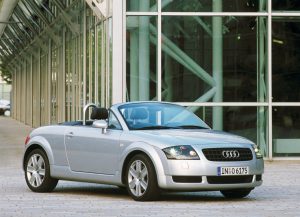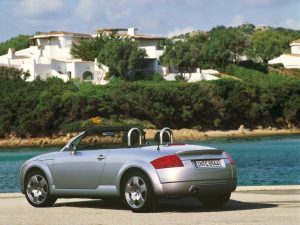Recalls: Audi 8N TT Roadster
Overview
Manufacturers, or importers, issue recalls for defects or faults which have the potential to cause injury. Generally, manufacturers will inform the original buyers if their vehicle is subject to a recall and of the steps required to remedy the defect or fault. Please note that the recalls below (if any) are for Australian-delivered vehicles only. Furthermore, the number of recalls should not be taken as an indication of a model’s reliability or its safety more generally.
Recalls: Audi 8N TT Roadster
Audi 8N TT Roadster quattro: rear ball joint corrosion
In October 2001, a recall was issued for Audi 8N TT quattro vehicles. In these vehicles, moisture could enter the ball joints on the rear axles which could start corrosion inside the ball joints and possibly cause them to seize (PRA 2001/4996).
Audi 8N TT Roadster: airbag may not deploy as intended
In February 2004, a recall was issued for Audi 8N TT Roadster vehicles fitted with three-spoke steering wheels. In the event of an accident with a collision impact above the triggering threshold of the airbags, the driver’s airbag may not deploy as intended (PRA 2004/6793).
2000 model year Audi 8N TT Roadster: Takata airbag and vehicle buyback
In December 2019, recall campaign 69AE was issued for 2000 model year Audi 8N TT Roadster vehicles. These recalled vehicles had Takata airbags and, over time, moisture could enter the airbag inflators and degrade the airbag propellant. If this occurred, deployment of the airbag could cause the airbag inflator housing to rupture and project metal fragments into the vehicle’s cabin – these fragments posed a serious risk of injury and fatality. The airbag could also under-inflate and not protect the driver as intended. As part of this recall, Audi Australia would offer to purchase the registered vehicle from the owner at present market value (i.e. as determined by a third party valuer appointed by Audi). Due to the age of the vehicles, replacement airbag inflators were not available. For the VINs of the recalled vehicles, please see PRA 2019/18002.
2000-01 Audi 8N TT Roadster with three-spoke steering wheel: Takata airbag recall
In November 2021, recall campaign 69CJ was issued for 2000-01 Audi 8N TT Roadsters. The propellant in the gas generator of the Takata NADI 5-AT airbag that was fitted to certain vehicles with three-spoke steering wheels may degrade over time. As a result, the driver’s airbag may deploy with reduced force and this could increase the risk of injury to vehicle occupants in the event of a collision. For the VINs of the recalled vehicles, please see REC-004987.
Problems and faults: Audi 8N TT Roadster
Overview
This section identifies potential problems, causes and fixes based on the experiences of owners and repairers, online sources and technical service bulletins. This information is provided solely for reference purposes and AustralianCar.Reviews recommends that only properly qualified persons carry out repairs or modifications. Furthermore, the number of items below should not be taken as an indicator of a model’s reliability or the frequency with which they may occur.
To report a problem or fault to the AustralianCar.Reviews team, please use the Contact Us form. Note that AustralianCar.Reviews does not offer advice on automotive problems or disputes; such enquiries will not receive a reply. For vehicles purchased from dealers after 1 January 2011, please see our Australian Consumer Law fact sheet.
Problems and faults: Audi 8N TT Roadster
- A rough or low idle may be due to a dirty throttle body bore or faulty throttle control module.
- For models fitted with the 3.2-litre V6 petrol engine, coolant may leak from the thermostat housing due to a bad O-ring or cracked housing. Furthermore, backfires may dislodge the idle control damper from the rear of the engine and cause a rough (or no) idle due to faulty plugs or wires.
- For models with turbocharged engines, the engine may make groaning or howling noises due to a problem with the charge pressure valve – a revised valve was subsequently released.
- To improve stability and handling, front-wheel drive models were fitted with revised front stabilisers, while quattro models were fitted with revised front and rear stabilisers.
- The audio speakers may emit a whining noise if the CD player and rear demister are operated in conjunction – this requires a filter to be fitted on the wiring harness.
- For early models, hoists or floor jacks may damage the sill panels; later models were fitted with hoist lift pads that can be retrofitted.




